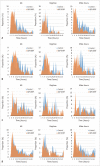Clinical Impact of a Quality Improvement Program Including Dedicated Emergency Radiology Personnel on Emergency Surgical Management: A Propensity Score-Matching Study
- PMID: 35926842
- PMCID: PMC9434742
- DOI: 10.3348/kjr.2022.0278
Clinical Impact of a Quality Improvement Program Including Dedicated Emergency Radiology Personnel on Emergency Surgical Management: A Propensity Score-Matching Study
Abstract
Objective: To investigate the clinical impact of a quality improvement program including dedicated emergency radiology personnel (QIP-DERP) on the management of emergency surgical patients in the emergency department (ED).
Materials and methods: This retrospective study identified all adult patients (n = 3667) who underwent preoperative body CT, for which written radiology reports were generated, and who subsequently underwent non-elective surgery between 2007 and 2018 in the ED of a single urban academic tertiary medical institution. The study cohort was divided into periods before and after the initiation of QIP-DERP. We matched the control group patients (i.e., before QIP-DERP) to the QIP-DERP group patients using propensity score (PS), with a 1:2 matching ratio for the main analysis and a 1:1 ratio for sub-analyses separately for daytime (8:00 AM to 5:00 PM on weekdays) and after-hours. The primary outcome was timing of emergency surgery (TES), which was defined as the time from ED arrival to surgical intervention. The secondary outcomes included ED length of stay (LOS) and intensive care unit (ICU) admission rate.
Results: According to the PS-matched analysis, compared with the control group, QIP-DERP significantly decreased the median TES from 16.7 hours (interquartile range, 9.4-27.5 hours) to 11.6 hours (6.6-21.9 hours) (p < 0.001) and the ICU admission rate from 33.3% (205/616) to 23.9% (295/1232) (p < 0.001). During after-hours, the QIP-DERP significantly reduced median TES from 19.9 hours (12.5-30.1 hours) to 9.6 hours (5.7-19.1 hours) (p < 0.001), median ED LOS from 9.1 hours (5.6-16.5 hours) to 6.7 hours (4.9-11.3 hours) (p < 0.001), and ICU admission rate from 35.5% (108/304) to 22.0% (67/304) (p < 0.001).
Conclusion: QIP-DERP implementation improved the quality of emergency surgical management in the ED by reducing TES, ED LOS, and ICU admission rate, particularly during after-hours.
Keywords: Dedicated emergency radiology; Emergency department length of stay; Intensive care unit admission rate; Quality improvement program; Timing of emergency surgery.
Copyright © 2022 The Korean Society of Radiology.
Conflict of interest statement
The authors have no potential conflicts of interest to disclose.
Figures




Similar articles
-
"One-way-street" streamlined admission of critically ill trauma patients reduces emergency department length of stay.Intern Emerg Med. 2017 Oct;12(7):1019-1024. doi: 10.1007/s11739-016-1511-x. Epub 2016 Jul 29. Intern Emerg Med. 2017. PMID: 27473424
-
Factors related to delayed intensive care unit admission from emergency department-A retrospective cohort study.Acta Anaesthesiol Scand. 2019 Aug;63(7):939-946. doi: 10.1111/aas.13355. Epub 2019 Mar 18. Acta Anaesthesiol Scand. 2019. PMID: 30883672
-
Patients admitted via the emergency department to the intensive care unit: An observational cohort study.Emerg Med Australas. 2019 Apr;31(2):225-233. doi: 10.1111/1742-6723.13123. Epub 2018 Jul 11. Emerg Med Australas. 2019. PMID: 29998569
-
Quality of care, resource use and patient outcome by use of emergency response team compared with standard care for critically ill medical patients in the emergency department: a retrospective single-centre cohort study from Norway.BMJ Open. 2021 Aug 12;11(8):e047264. doi: 10.1136/bmjopen-2020-047264. BMJ Open. 2021. PMID: 34385247 Free PMC article.
-
Reducing the length of stay of cardiac patients in the Adult Emergency department by using a Quality improvement framework.Int Emerg Nurs. 2023 Nov;71:101368. doi: 10.1016/j.ienj.2023.101368. Epub 2023 Oct 19. Int Emerg Nurs. 2023. PMID: 37864950 Review.
Cited by
-
Does timely reporting of preoperative CT scans influence outcomes for patients following emergency laparotomy?Ann R Coll Surg Engl. 2025 Feb;107(2):146-150. doi: 10.1308/rcsann.2023.0040. Epub 2024 Jun 13. Ann R Coll Surg Engl. 2025. PMID: 38869096 Free PMC article.
-
Clinical Outcomes and Cost-Effectiveness of Osteoporosis Screening With Dual-Energy X-ray Absorptiometry.Korean J Radiol. 2023 Dec;24(12):1249-1259. doi: 10.3348/kjr.2023.0555. Korean J Radiol. 2023. PMID: 38016684 Free PMC article.
References
-
- Peden CJ, Stephens T, Martin G, Kahan BC, Thomson A, Rivett K, et al. Effectiveness of a national quality improvement programme to improve survival after emergency abdominal surgery (EPOCH): a stepped-wedge cluster-randomised trial. Lancet. 2019;393:2213–2221. - PubMed
-
- Jalal S, Ouellette H, Ante Z, Munk P, Khosa F, Nicolaou S. Impact of 24/7/365 attending radiologist coverage on the turnaround time in an emergency and trauma radiology department. Can Assoc Radiol J. 2021;72:548–556. - PubMed
-
- Lamb L, Kashani P, Ryan J, Hebert G, Sheikh A, Thornhill R, et al. Impact of an in-house emergency radiologist on report turnaround time. CJEM. 2015;17:21–26. - PubMed
MeSH terms
LinkOut - more resources
Full Text Sources

